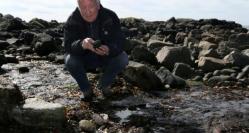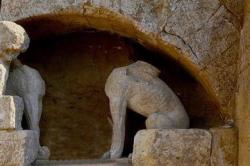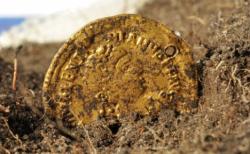INSTITUT SUPERIEUR D'ANTHROPOLOGIE
INSTITUTE OF ANTHROPOLOGY
ONLINE COURSES / COURS A DISTANCE
FALL TERM : OCTOBER 2014
REGISTER NOW
IRLANDE –  Lippa - The north Connemara coastline could be one of this island’s richest “time capsules” of life before sea levels rose, according to State archaeologists who have removed a 3,700-year-old structure from the shore in Co Galway. A team from the Underwater Archaeology Unit has excavated the entire oak structure, resembling an ancient trackway, which was exposed on the coastline at Lippa near Spiddal by last winter’s storms. The “trackway”, discovered earlier this spring, may in fact be a very well-preserved and highly significant example of a fulacht fiadh, or ancient cooking place, constructed at a time when forests and lagoons extended out into what is now Galway Bay. The timbers could be part of a wooden trough which was encircled by 17 hazel rod stakes, according to the unit’s head,Finbarr Moore. “It is very significant, as it is unusual to find a fulacht fiadh at such a level of preservation, but the sea obviously conserved it when levels began to rise,” he said. “While thousands of fulacht fiadh have been recorded and excavated during road-building schemes, most of them are stone-lined and have a mound of burnt stone nearby. We found no firecracked stones near this structure, but the wattle surround could be unique.”The structure was identified by Galway resident Alan Keogh while out walking the shoreline. He alerted NUI Galway geologist Prof Mike Williams, who has done extensive research on the topography of the area, including the 7,500-year-old “drowned forests” recently uncovered along the Atlantic seaboard. Prof Williams’s initial estimate that it could be of late Neolithic or early Bronze Age origin was backed up by radiocarbon analysis undertaken by local community activist Seán Ó Coistealbha which dated it to 1,700 BC.
Lippa - The north Connemara coastline could be one of this island’s richest “time capsules” of life before sea levels rose, according to State archaeologists who have removed a 3,700-year-old structure from the shore in Co Galway. A team from the Underwater Archaeology Unit has excavated the entire oak structure, resembling an ancient trackway, which was exposed on the coastline at Lippa near Spiddal by last winter’s storms. The “trackway”, discovered earlier this spring, may in fact be a very well-preserved and highly significant example of a fulacht fiadh, or ancient cooking place, constructed at a time when forests and lagoons extended out into what is now Galway Bay. The timbers could be part of a wooden trough which was encircled by 17 hazel rod stakes, according to the unit’s head,Finbarr Moore. “It is very significant, as it is unusual to find a fulacht fiadh at such a level of preservation, but the sea obviously conserved it when levels began to rise,” he said. “While thousands of fulacht fiadh have been recorded and excavated during road-building schemes, most of them are stone-lined and have a mound of burnt stone nearby. We found no firecracked stones near this structure, but the wattle surround could be unique.”The structure was identified by Galway resident Alan Keogh while out walking the shoreline. He alerted NUI Galway geologist Prof Mike Williams, who has done extensive research on the topography of the area, including the 7,500-year-old “drowned forests” recently uncovered along the Atlantic seaboard. Prof Williams’s initial estimate that it could be of late Neolithic or early Bronze Age origin was backed up by radiocarbon analysis undertaken by local community activist Seán Ó Coistealbha which dated it to 1,700 BC.
https://www.irishtimes.com/news/ireland/irish-news/ancient-oak-structure-from-connemara-coast-excavated-and-taken-into-state-care-1.1900755
ROYAUME UNI - Anstey - An archaeological dig in Anstey has revealed new clues about the village’s past. Test pits dug around Anstey revealed the foundations of demolished cottages from two different periods, animal bones, and Roman pottery. The items spanned two thousand years of the village’s history, the majority from the 11th or 12th century onwards. Some test pits also contained fragments of flint from early tool making.
http://www.loughboroughecho.net/news/local-news/archaeological-dig-held-in-anstey-7609317
TURQUIE –  Patara - Excavations ongoing in the ancient city of Patara in the southern province of Antalya have revealed two figurines dating back to 3,000 and 7,000 B.C. According to reports, the stone figurines, which had not been discovered in earlier excavations, reveal the connection between the Bronze Age and Anatolian cultures. The other figurine that was found during the excavations is made of earthenware and highlights the importance of the Patara Port in ancient times. The figurine from the eastern Mediterranean depicts the goddess Astarte, who is the goddess of fertility. Although it reflects the artistic features of Ionian civilization, the Astarte figurine was found along with Cypriot ceramics. The head of the excavations, Professor Havva İşkan Işık at Akdeniz University’s Archaeology Department, said the history of Lycia would be rewritten with these new findings.
Patara - Excavations ongoing in the ancient city of Patara in the southern province of Antalya have revealed two figurines dating back to 3,000 and 7,000 B.C. According to reports, the stone figurines, which had not been discovered in earlier excavations, reveal the connection between the Bronze Age and Anatolian cultures. The other figurine that was found during the excavations is made of earthenware and highlights the importance of the Patara Port in ancient times. The figurine from the eastern Mediterranean depicts the goddess Astarte, who is the goddess of fertility. Although it reflects the artistic features of Ionian civilization, the Astarte figurine was found along with Cypriot ceramics. The head of the excavations, Professor Havva İşkan Işık at Akdeniz University’s Archaeology Department, said the history of Lycia would be rewritten with these new findings.
http://www.hurriyetdailynews.com/unique-figurines-found-in-patara.aspx?pageID=238&nid=70641&NewsCatID=375
GRECE –  Amphipolis - Two sphinxes weighing around 1.5 tons each will not be moved from the entrance to the tomb at Ancient Amphipolis currently being excavated by archaeologists. It has also been decided that a mosaic displaying black and white rhombus shapes will not be moved either, Kathimerini has been told. Technical work began on Monday at the tomb in Central Macedonia, northern Greece, to ensure there will be no collapse or other damage as archaeologists attempt to enter the tomb and discover what lies inside. There are indications that the tomb has been raided in the past but archaeologists are not yet in a position to confirm this. The tomb dates to between 325 and 300 BC, which coincides with the time when Alexander the Great died. He lost his life in 323 BC in Babylon, modern-day Iraq, but was later buried in Egypt. The Macedonian king’s final resting place is not known. However, experts have played down the possibility of the tomb on Kasta Hill containing his remains. Alexander’s Persian wife, Roxana, and his son, Alexander IV, were banished to Amphipolis and murdered there in around 310 BC on the orders of Cassander, who became king of Macedon. Archaeologists tend to favor the interpretation that an important Macedonian official was buried at Amphipolis. The mound is surrounded by a 497-meter circular wall built with Thasian marble, leading the premier to label it a “unique” site. A 4.5-meter-wide road leads to the tomb’s entrance.
Amphipolis - Two sphinxes weighing around 1.5 tons each will not be moved from the entrance to the tomb at Ancient Amphipolis currently being excavated by archaeologists. It has also been decided that a mosaic displaying black and white rhombus shapes will not be moved either, Kathimerini has been told. Technical work began on Monday at the tomb in Central Macedonia, northern Greece, to ensure there will be no collapse or other damage as archaeologists attempt to enter the tomb and discover what lies inside. There are indications that the tomb has been raided in the past but archaeologists are not yet in a position to confirm this. The tomb dates to between 325 and 300 BC, which coincides with the time when Alexander the Great died. He lost his life in 323 BC in Babylon, modern-day Iraq, but was later buried in Egypt. The Macedonian king’s final resting place is not known. However, experts have played down the possibility of the tomb on Kasta Hill containing his remains. Alexander’s Persian wife, Roxana, and his son, Alexander IV, were banished to Amphipolis and murdered there in around 310 BC on the orders of Cassander, who became king of Macedon. Archaeologists tend to favor the interpretation that an important Macedonian official was buried at Amphipolis. The mound is surrounded by a 497-meter circular wall built with Thasian marble, leading the premier to label it a “unique” site. A 4.5-meter-wide road leads to the tomb’s entrance.
http://www.ekathimerini.com/4dcgi/_w_articles_wsite1_1_19/08/2014_542221?
ALLEMAGNE –  Vogelherd Cave - Archaeologists from the University of Tübingen have found an ancient fragment of ivory belonging to a 40,000 year old animal figurine. Both pieces were found in the Vogelherd Cave in southwestern Germany, which has yielded a number of remarkable works of art dating to the Ice Age. The mammoth ivory figurine depicting a lion was discovered during excavations in 1931. The new fragment makes up one side of the figurine’s head, and the sculpture may be viewed at the Tübingen University Museum. “The figurine depicts a lion,” says Professor Nicholas Conard of Tübingen University’s Institute of Prehistory and Medieval Archaeology, and the Senckenberg Center for Human Evolution and Palaeoenvironment Tübingen. “It is one of the most famous Ice Age works of art, and until now, we thought it was a relief, unique among these finds dating to the dawn of figurative art. The reconstructed figurine clearly is a three dimensional sculpture.” The new fragment was discovered when today’s archaeologists revisited the work of their predecessors from the 1930s. “We have been carrying out renewed excavations and analysis at Vogelherd Cave for nearly ten years,” says Conard. “The site has yielded a wealth of objects that illuminate the development of early symbolic artifacts dating to the period when modern humans arrived in Europe and displaced the indigenous Neanderthals.” He points out that the Vogelherd Cave has provided evidence of the world’s earliest art and music and is a key element in the push to make the caves of the Swabian Jura a UNESCO World Heritage site. Vogelherd is one of four caves in the region where the world’s earliest figurines have been found, dating back to 40,000 years ago. Several dozen figurines and fragments of figurines have been found in the Vogelherd alone, and researchers are piecing together thousands of mammoth ivory fragments.
Vogelherd Cave - Archaeologists from the University of Tübingen have found an ancient fragment of ivory belonging to a 40,000 year old animal figurine. Both pieces were found in the Vogelherd Cave in southwestern Germany, which has yielded a number of remarkable works of art dating to the Ice Age. The mammoth ivory figurine depicting a lion was discovered during excavations in 1931. The new fragment makes up one side of the figurine’s head, and the sculpture may be viewed at the Tübingen University Museum. “The figurine depicts a lion,” says Professor Nicholas Conard of Tübingen University’s Institute of Prehistory and Medieval Archaeology, and the Senckenberg Center for Human Evolution and Palaeoenvironment Tübingen. “It is one of the most famous Ice Age works of art, and until now, we thought it was a relief, unique among these finds dating to the dawn of figurative art. The reconstructed figurine clearly is a three dimensional sculpture.” The new fragment was discovered when today’s archaeologists revisited the work of their predecessors from the 1930s. “We have been carrying out renewed excavations and analysis at Vogelherd Cave for nearly ten years,” says Conard. “The site has yielded a wealth of objects that illuminate the development of early symbolic artifacts dating to the period when modern humans arrived in Europe and displaced the indigenous Neanderthals.” He points out that the Vogelherd Cave has provided evidence of the world’s earliest art and music and is a key element in the push to make the caves of the Swabian Jura a UNESCO World Heritage site. Vogelherd is one of four caves in the region where the world’s earliest figurines have been found, dating back to 40,000 years ago. Several dozen figurines and fragments of figurines have been found in the Vogelherd alone, and researchers are piecing together thousands of mammoth ivory fragments.
http://artdaily.com/news/72231/T-bingen-archaeologists-find--new--fragment-of-ivory-belonging-to-40-000-year-old-lion?#.U_N0k_l_upA
SUEDE –  Öland - Swedish archaeologists found a rare and valuable golden coin from ancient Rome on Monday. And they think it may explain a key part of the Sweden's history. Archaeologists found the coin on Monday at a site on the island of Öland that's been compared to Italy's Pompeii. A small team of archaeologists at Kalmar County museum, in collaboration with Lund University, has been digging at the site for the past three years. The team is studying the Migration Period in Scandinavian history, from about 400 to 550 AD, centuries before the Viking Age. While the team has found several hundred of the coin already, Monday's discovery was a big one, said archaeologist and project manager Helena Victor. "This is the first one found in an archaeological context," she told The Local. "Normally we find them while we're plowing the field. But we found this one inside a house where we found people who'd been killed." The object, a small golden coin also known as a solidus, is from the Roman Empire and may be an important puzzle piece in mapping the island's history. "We think it may have been the reason for the massacre at the Sandby Borg fort. And this is the only coin that wasn't taken," she explained. "We found it on the edge of a posthole in the house. So maybe the robbers came to take the treasure there, and maybe they ripped the bag and one coin fell down into the posthole in the floor, and there it remained."
Öland - Swedish archaeologists found a rare and valuable golden coin from ancient Rome on Monday. And they think it may explain a key part of the Sweden's history. Archaeologists found the coin on Monday at a site on the island of Öland that's been compared to Italy's Pompeii. A small team of archaeologists at Kalmar County museum, in collaboration with Lund University, has been digging at the site for the past three years. The team is studying the Migration Period in Scandinavian history, from about 400 to 550 AD, centuries before the Viking Age. While the team has found several hundred of the coin already, Monday's discovery was a big one, said archaeologist and project manager Helena Victor. "This is the first one found in an archaeological context," she told The Local. "Normally we find them while we're plowing the field. But we found this one inside a house where we found people who'd been killed." The object, a small golden coin also known as a solidus, is from the Roman Empire and may be an important puzzle piece in mapping the island's history. "We think it may have been the reason for the massacre at the Sandby Borg fort. And this is the only coin that wasn't taken," she explained. "We found it on the edge of a posthole in the house. So maybe the robbers came to take the treasure there, and maybe they ripped the bag and one coin fell down into the posthole in the floor, and there it remained."
http://www.thelocal.se/20140818/gold-coin-from-ancient-rome-found-in-sweden